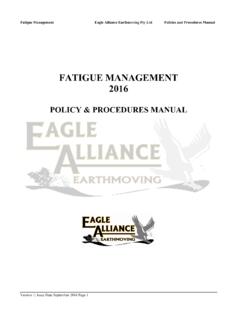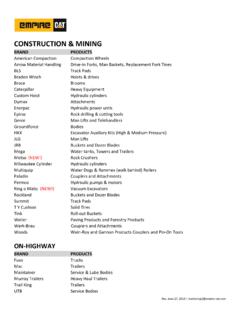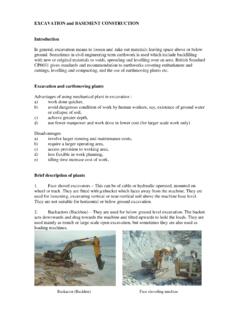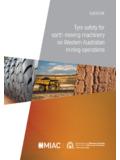Transcription of Guidance on Lifting with Excavators
1 Lifting Operations with 180 and 360 Excavators Lifting Operations with Excavators Strategic Forum for Construction Good Practice Guide Working in Partnership Reference No. CIG 0801. First Published: May 2008. First Revision: October 2008. Second Revision: March 2009. Third Revision November 2017. Published by: Construction Plant-hire Association 27/28 Newbury St London EC1A 7HU. Telephone: 020 7796 3366. Email: CPA Copyright 2008, 2009 & 2017. 2. CPA Copyright XXXX 2010. Contents Page Foreword 4. 1. Introduction and Summary 5. 2. Definitions .. 7. 3. Planning and Supervision of Lifting Operations .. 11. 4. Selection of Excavators Used for Lifting .. 20. 5.
2 Planning, Supervisory and Operating Personnel . 31. 6. Specific Issues .. 38. 7. Maintenance and Inspection .. 50. 8. Thorough Examination .. 53. Annex A Non-Exhaustive List of Hazards for Lifting with Excavators 55.. Annex B Case Studies Illustrating Lift Category .. 56. Annex C Example of a Checklist for Lift Planning .. 60. Annex D Example of a Checklist for Familiarisation .. 61. Annex E Example of Daily (pre-use) Checks 62. Key Points for Excavator Operators - Lifting and Travelling with Annex F. Suspended Loads .. 64. Key Points for Supervisors of Excavator Operators - Lifting and Annex G. Travelling with Suspended Loads .. 65. Annex H Tyre Maintenance, Repair and Replacement.
3 66. Annex I Further Information and Guidance .. 69. Annex J Working Group Membership 72. NOTE: Whilst every care has been taken to ensure the accuracy of the material contained within this booklet, no liability is accepted by the Construction Plant-hire Association in respect of the information given. No material from this booklet may be reproduced in any shape or form without the permission of the Construction Plant- hire Association. Lifting Operations with Excavators 3 November 2017. Foreword Excavators are often used to lift loads on construction sites, they are however, primarily designed as earthmoving machinery and not as Lifting equipment. Consequently when undertaking out Lifting operations using Excavators care must be taken to plan, supervise and carry out each lift in the same way as with other Lifting equipment, taking account of the additional risks.
4 Failure to do so has, in the past, led to a significant number of serious accidents, some tragically fatal. Not only do these accidents have a terrible cost in terms of human suffering, they also have a significant financial cost for all concerned. There is therefore a very strong business case for improving safety performance. Carrying out Lifting operations with Excavators safely depends on a number of factors including the planning and supervision of Lifting operations, selection of Excavators , competence of personnel, and maintenance and through examination of Lifting equipment. If any of these are deficient, the risk of a serious accident increases significantly and it is therefore essential that all of those involved ensure that all Lifting operation with Excavators are planned, managed, supervised and carried out safely by competent people.
5 The purpose of this Guidance is to help those involved with planning and carrying out Lifting operations using Excavators to achieve a better awareness of the particular risks involved and the measures that can be put in place to mitigate those risks. This Guidance has been developed by a working group representing all parts of the industry. It provides clarity on Lifting with Excavators and will help excavator suppliers and users improve health and safety standards. The Guidance addresses planning, machine selection, people and additional measures to reduce the risks associated with Lifting operations. The advice in this document is straightforward, comprehensive and easy to adopt.
6 This Guidance may go further than the minimum you need to do to comply with the law. I thank those who have been involved in its preparation and commend the Guidance to anyone who manages, plans supervises or carries out Lifting operations with Excavators . Please read the publication and turn the advice into action. Kevin Minton Director Construction Plant-hire Association Lifting Operations with Excavators 4 November 2017. Introduction and Summary All Lifting operations in the UK must comply with the requirements of the Lifting Operations and Lifting Equipment Regulations 1998, commonly known as LOLER. The Approved Code of Practice and Guidance to LOLER refers to the BS 7121 saying: The BS 7121 series of standards contains recommendations for the safe use of cranes, including planning of Lifting operations.
7 In this series of standards the competent person for planning Lifting operations is referred to as the appointed person. The principles contained in this series of standards can be applied to the use of other types of Lifting equipment.. Part of the planning process for Lifting operations involves selection of suitable Lifting equipment for the particular task to eliminate or reduce Lifting related risks to people in the workplace. The Provision and Use of Work Equipment Regulations 1998 (PUWER). require employers to ensure that work equipment is suitable for the purpose for which it is used or provided' and that they take account of any additional risks posed by the use of the equipment.
8 In terms of selection of Lifting equipment this means that the first choice should always be machines which have been specifically designed for Lifting operations, such as cranes, telehandlers and lorry loaders. When using an excavator to carry out Lifting operations it should be borne in mind that Excavators are primarily for excavating and handling loose material, rather than Lifting suspended loads. This introduces several additional risks when carrying out Lifting operations that are not present with conventional cranes. These include: Fast articulation and slew movements of the boom, dipper arm and bucket (if fitted) which may put persons in the vicinity of the machine at risk and may also affect the stability of the machine.
9 Conventional cranes are designed with slower motions for the precision placement of loads, rather than the fast motions of an excavator to maximise earthmoving production;. NOTE: Some Excavators have a selectable lift mode which limits some or all motion speeds during Lifting operations. The need to operate boom and dipper arms simultaneously to keep the load over the same point on the horizontal plane, whilst Lifting or lowering;. Standard excavator rated capacity alarms only warn of approach to overload, rather than preventing overload as is the case with conventional cranes of all types over 1 tonne capacity;. Provision for the operator to switch off the alarm to prevent nuisance alarms during earthmoving operations.
10 Standard excavator overload warning devices are generally rated with the excavator in its least stable condition cross carriage. This means that when Lifting in line with the tracks/wheels, the alarm will activate well before the maximum rated radius for the load is reached. This frequently leads to operator frustration and switching off the indicator;. Excavators have the ability to travel with a load on uneven ground even though most load radius charts only cover static Lifting ;. NOTE: Excavators should not be used for pick and carry duties if they do not have a pick and carry load chart. Not all excavator operators have been trained and assessed in carrying out Lifting operations with Excavators .










